Cymbidium Orchid Care - Boat Orchids

The Plant: An extravagant, oriental orchid, cymbidiums produce long sprays of waxy flowers in a variety of colours, creamy white through to rich magenta, above tough strap-like grass-green leaves. It it native to many tropical areas in the world and can either be epiphytic or terrestrial.
They all have stunning flowers on either short or long arching racemes. A magnificent sight if you venture across a tree-growing epiphytic variety. When grown as houseplants, Cymbidium Orchids normally flower in the winter months an added attraction.
This group of orchids can be a little untidy in that the houseplant types normally have long strap-like leaves. The flowers emerge from the base on long stems. Most can be grown either fully ot partially as epiphytes if wired to an old attractive tree trunk or substantial moss pole which will also aid humidity.
Many varieties have bulbous swellings which are mistaken for bulbs.
The Cymbidium is classed as a cool area orchid, so does not require high, humid temperatures especially in the winter. However, they are generally not hardy enough to withstand freezing or near frost temperatures.
Care of Cymbidiums
Its needs: Bright light essential but avoid direct sun. Good ventilation required to keep Cymbidiums healthy, and in particular a generally cool environment. Cooler temperatures are particularly important at night for success with flowering and overall plant well being. A specialist orchid potting mix should be used which allows very good drainage.
 General
Care: Water freely throughout the summer growing season,
and use a specialist orchid fertiliser once a month. Mist spray in
hot weather. Re-pot only if plant has really outgrown its container.
This should be done immediately after flowering but only if really
necessary. It is far better to have this orchid pot bound.
General
Care: Water freely throughout the summer growing season,
and use a specialist orchid fertiliser once a month. Mist spray in
hot weather. Re-pot only if plant has really outgrown its container.
This should be done immediately after flowering but only if really
necessary. It is far better to have this orchid pot bound.
Therein lies a small problem in that the plant can become top-heavy in a small restrictive pot. It can be kept tidy but inserting a few light canes around the pot to support the wayward foliage bit do not tie the foliage I too tightly. It needs air circulation
Good for: Cymbidiums are excellent. Exotic, long-lasting, blooms make this an attractive gift.
Problems with Cymbidium Orchids
As with many plants grown indoors, they can be attacked by mealy bug, Red spider mite, and scale pest.
Cymbidium Orchids: A Comprehensive Guide to Identification and Problem Resolution
Cymbidium orchids are known for their beautiful, long-lasting flowers and vibrant green foliage. They're relatively easy to care for compared to other orchid varieties, but like all plants, they can still encounter problems. Here's a guide to help you identify and resolve common challenges with Cymbidium orchids.-
1. Growth Requirements:
- Light: Cymbidiums prefer bright, indirect light. Direct sunlight can scorch the leaves, while insufficient light can prevent blooming.
- Water: Water thoroughly when the top inch of potting mix is dry, usually once a week in summer and less frequently in winter. Overwatering can cause root rot.
- Temperature: Cymbidiums enjoy cooler temperatures, ideally between 50°F (10°C) and 85°F (29°C). They need a significant temperature drop at night to trigger blooming.
- Humidity: Aim for 40-60% humidity. Too low humidity can lead to brown leaf tips, while too high can promote fungal diseases.
- Soil: Use a well-draining orchid mix typically composed of bark, perlite, and charcoal. Heavy, water-retentive soils can suffocate the roots.
- Yellow Leaves: This can be caused by overwatering, excessive light, or nutrient deficiency. Adjust watering, move the plant to a less sunny spot, or feed with a balanced orchid fertilizer.
- Wilting or Wrinkled Pseudobulbs (the thickened part of the stem where the leaves grow from): This is often a sign of underwatering or root rot. Increase watering, but if the problem persists, unpot the orchid and check for mushy, rotten roots. If found, remove them and repot the orchid.
- No Blooms: Lack of flowering is typically due to insufficient light or inadequate temperature variations. Move your orchid to a brighter location and ensure it experiences a 10-15 degree Fahrenheit drop in temperature at night.
- Pests (such as aphids, scale insects, or spider mites): Isolate the infested plant and treat with an insecticidal soap or neem oil. For severe infestations, a systemic insecticide may be necessary.
- Regular Inspection: Check your orchid regularly for signs of pests or disease. Early detection makes treatment easier and more effective.
- Proper Watering: Water thoroughly, but let the potting mix dry out slightly between waterings to prevent root rot.
- Good Ventilation: Ensure your orchid has good air circulation. This helps prevent fungal diseases and also aids in proper gas exchange.
- Appropriate Fertilization: Feed your orchid regularly with a balanced orchid fertilizer to provide essential nutrients. Over-fertilizing can lead to salt buildup, which can damage roots.
Remember, patience and observation are key in orchid care. With the right conditions and timely problem-solving, your Cymbidium orchid can thrive and produce stunning blooms for years to come.
Propagation of Cymbidiums
For a few added plants, the main plant can be divided in early spring right after flowering. This works well with pot bound plants.
Otherwise pseudo bulbs can also be individually detached and re-potted again after flowering.
Cymbidium Orchids Propagation Guide
Cymbidium orchids, often referred to as boat orchids, are known for their stunning, long-lasting blooms. While they're a bit more complex to propagate than some other plants, with the right tools and knowledge, you can successfully propagate your own Cymbidium orchids.
Tools Needed:- A healthy mature Cymbidium orchid
- Sharp, clean pruning shears or a knife
- A pot or tray
- Orchid potting mix
- Rooting hormone (optional)
The primary methods of propagating Cymbidium orchids are division and back bulb propagation.
-
1. Division:
This is the simplest method of propagation and is best done in spring after the plant has finished blooming.
- Step 1: Gently remove the orchid from its pot and shake off any loose potting mix.
- Step 2: Using your hands or a clean, sharp tool, separate the pseudobulbs (the swollen, bulb-like structures at the base of the plant). Each division should have at least three healthy pseudobulbs.
- Step 3: Repot each division into a pot with fresh orchid potting mix. Water thoroughly.
-
2. Back Bulb Propagation:
This method involves propagating from old pseudobulbs that have stopped producing leaves but can still grow new plants.
- Step 1: Remove the orchid from its pot and identify a pseudobulb that is leafless but still firm and green.
- Step 2: Cut off the pseudobulb with a clean, sharp tool, making sure to include a bit of the rhizome (the horizontal stem from which the pseudobulbs grow).
- Step 3: You can dust the cut end with rooting hormone, but this isn't essential.
- Step 4: Pot up the back bulb in a small pot with fresh orchid potting mix, burying only the bottom third of the bulb.
- Step 5: Place the pot in a warm, bright location and keep the potting mix lightly moist. New growth should appear within a few months.
-
Common Challenges and Tips:
- Disease: Always use clean tools to prevent the spread of disease. If a pseudobulb or division looks diseased, discard it.
- Slow growth: Cymbidiums are slow-growing plants. Be patient and give new divisions or back bulbs plenty of time to establish.
- Care of new plants: Treat new divisions or plants grown from back bulbs as you would mature plants. They need bright, indirect light, regular watering, and feeding with a balanced orchid fertilizer.
Remember, patience and care are key when propagating Cymbidium orchids. But once you see new growth developing, all your hard work will be rewarded!
Best Selling Gardening Products
Popular Gardening Sections

Problems
Identify Weeds in The Garden - How to deal with weeds. Diseases and Pest which harm your garden and plants, learn how to prevent, deter and erradicate your garden problems.
Garden Problems
Pruning
Pruning Guide. Shrubs flower better with correct pruning. Many illustrations and examples of what to do - and when. Includes evergreens, roses, flowering shrubs, spring flowering shrubs and pruning for stem effect. This is our most viewed and comprehensive section,
Pruning
Gardening Businesses
Gardening Businesses listed in the UK counties and USA states. County and State Listings of businesses involved in Garden supplies and services. If you wish to be added to the Directory, please send us your information. Having problems, use the search box
Businesses
Gardening
In this section you will learn about Gardening Basics, Containers, Landscaping, Propagation and Soil.
Gardening
Gardening Gifts
Gardening Gifts and Reviews, Read Before you Buy
- Gardening Gifts Ideas
- Gifts For Her
- Gifts For Men
- Power Tool Gifts
- Cheap Gifts
- Personalised Gifts
- Wildlife Gifts
- Family Gifts



